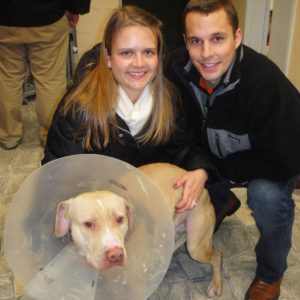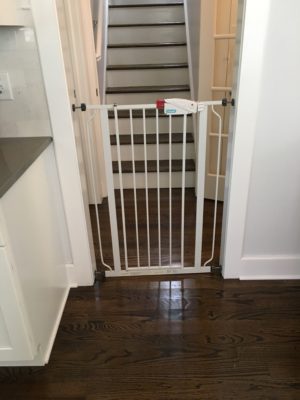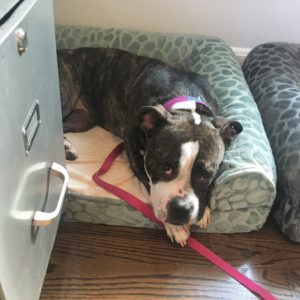
The day we brought home a terrified Beau (March 3, 2011).
After weeks, months (years?) of anticipation, the day is finally here! The day you bring your new dog home! You pick him up, help him into your car, and you’re headed home. But then what? Especially for first time dog parents, there can be a lot of questions about what the first day, with a new dog should look like. Hopefully these pointers will be helpful, and be sure to check out the follow up post, “Your first day with your new dog in a multi-dog household.”
If there is one key takeaway when it comes to advice about bringing a new dog home, it’s this:
Keep the dog’s world small.
It might be frustrating. Of course all you want to do is invite over all of your family and friends to let them meet your new dog. After all, they’ve been just as excited as you! Resist the urge (besides, this is what social media is for!) to do this. Instead, go into your first days with structure, boundaries, and routine. This will set your dog up for success.
Once you arrive home, take your dog on a nice walk around your neighborhood to tire him out and begin acclimating him. You’ll want to end your walk at “the bathroom” – wherever it is that they will be doing most of their pottying in their new home. Maybe you have a backyard, or an area in front of your apartment building. Encourage them to sniff for a while, hope that they go to the bathroom, and then head inside.
Make sure that you’ve already closed the doors to any “off limit” areas (if you have a very large house, it’s a good idea to keep your new dog’s area to just a few rooms or perhaps just one floor in the beginning) and let them sniff around. I recommend keeping the leash on your dog’s collar or harness, dragging behind him, so that if he jumps up on anything or starts going anywhere he shouldn’t you can guide him back to where he should be. (We actually have new dogs in our house drag a leash for at least a few days, and sometimes as long as a few weeks.)

A baby gate in our kitchen doorway kept Beau’s world small in the early days.
After your dog has sniffed for a while, bring him to wherever his crate is located. Toss some treats in the crate so that he goes in on his own accord, and then give your new dog something delightful to enjoy in the crate – a bully stick, a kong stuffed with wet food and peanut butter, or something similarly “high value.” Shut the door to your dog’s crate, and let him have some “alone time” as you go about your business elsewhere in your home.
Wait…alone time? But we just got home! I want to smother my new dog with love and snuggles!
Believe me, I get it, and I understand how counterintuitive it seems to bring your dog home and very soon after leave him alone in his crate. But it you don’t set up some expectations and “safe places” for your dog right off the bat, and instead spend every waking second with him from the moment you get home, the first time that you have to leave him home alone could come as a huge shock and lead to issues. By showing your dog that his crate is “his place,” you are keeping your dog’s world small, and only gradually expanding it.

Former foster dog Lucy, relaxing during the early days with her leash on her collar.
Don’t be surprised if your dog cries for a bit in the crate. This is okay. Eventually (and every dog is different) he should quiet down and enjoy the goodie you put in there for him. After an hour or two go let your dog out of his crate and take him back outside to “the bathroom.” (Note: you’ll want to let your dog out of the crate when he’s quiet, not if he’s barking or crying, since you don’t want to lead him to believe that being vocal gets him out of the crate.) From here, continue rotating time in the crate, time spent in the small/segregated area of your home while dragging a leash, and time out on walks. If you have a routine that you do just about every night (for instance, watching TV) then begin including your dog in that routine; by letting him know what is expected of him and how each day ends, he will build confidence and feel content in his new home.
Keep the routine simple and straightforward for at least the first week, but more likely the first two weeks or more. (If you adopted your dog, you might hear the term “two week shut down.”) Introduce new people and places slowly and gradually. If your new dog seems stressed or anxious, go back to the first day routine.
SaveSave

Leave a Reply